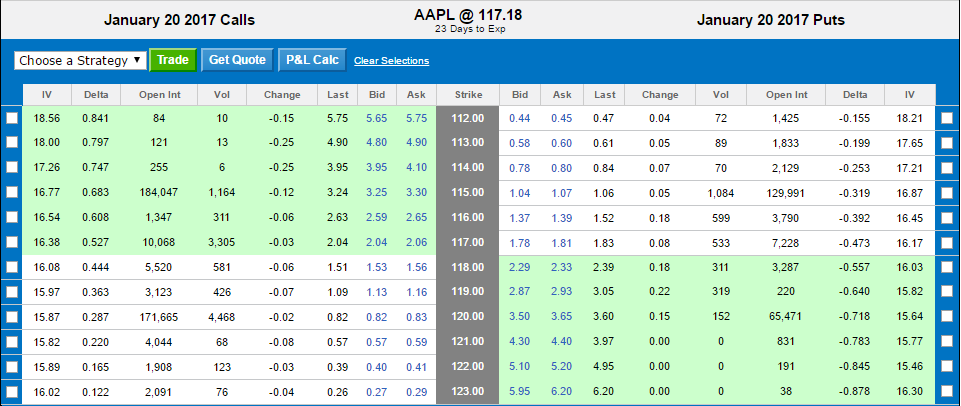Option chains are used for quoting options via a list of the available strike prices and expiration’s for the underlying security. In the example below we have an Apple ($AAPL) option chain for the January 20, 2017 expiration.
On the left side are all of the option calls, in the center is the strike price and on the right side is a list of puts you can trade.
The lightly shaded green area marks the option strikes that are in-the-money which are more expensive than options that are out-of-the-money. You will also notice that there is a bid and ask for each strike price along with volume and last print.
Options are not as liquid as equities and will generally have a wide spread.
Option Pricing
There is a lot that goes into option pricing so I’ll just cover the basics here. The main factors contributing to option pricing are time to expiration, implied volatility and its intrinsic value. The longer the time till expiration the more expensive the contracts will be because it has more time to reach or go past the strike price.
As time goes by time decay (theta) will start to erode the option prices which will really start to kick in on the last week before it expires.
Implied volatility is what the market thinks about the price range of the underlying security. So if there is a high implied volatility then the market thinks there will be a big move in the underlying and vice versa for low implied volatility.
When a company is coming close to releasing their earnings you will see implied volatility levels climbing into the earnings announcement and then deflate after it is released sucking a lot of premium out of the option prices. This is know as a volatility crush.
Intrinsic value is the amount of value in the option premium that is in-the-money. So if you have a call option contract with a strike price of $50 and the underlying security is trading at $60, there is $10 of intrinsic value built into the price of the option.
Warrior Trading Pro Tip
When trading options, especially directionals, it is best to look for options that have a Delta around .50, which is usually contracts with strike prices that are close to being at or slightly in-the-money.
The reason for this is because the higher the Delta the more reactive option prices will be to the price movements of the underlying. Contracts with low Deltas will need a bigger move in the underlying to move the price in the option.
The contracts will be more expensive with a higher Delta but will trade better especially if you’re looking to scalp them.



